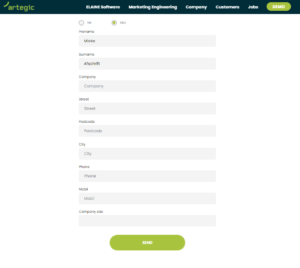How do you reduce scattering losses in e-mail marketing? Through individualization? Generally, yes, but much simpler yet equally effective is the “classic” segmentation of your distribution lists into different target groups. In this article you will learn about what you need to keep in mind.
What is segmentation?
In the course of segmentation, customers are grouped into different target groups on the basis of various characteristics, to which communication measures and offers tailored to this group are then played out. The characteristics used for segmentation can be of a socio-economic nature, such as age, gender, place of residence, etc., or can be based on purchase history, customer status, interests, time spent on the website, etc. The right segmentation can thus create a target group-specific approach, which increases relevance for customers and leads to better response rates compared to broadcasting/one-size-fits-all communication.
Segmentation is less precise and complex than complete individualization of communication, but in many cases it is already sufficient and, above all, much easier to implement. Differentiating between places of residence, gender, or between existing and new customers is simple, but can be very effective depending on the context. Often, a different sorting of the content can make all the difference. It is also important to test regularly – women do not always prefer pink and men do not always prefer blue.
Procedure for successful segmentation
The four essential steps in segmentation are: Data basis, customer selection, interpretation and implementation.
- Data basis: First of all, it is important to create a sufficient data basis in order to be able to segment your customers. In addition to master data such as place of residence and gender in B2C or industry and position in B2B, purchasing behavior is particularly insightful: What products do customers buy? In what frequency? How much do they spend? Which payment methods do they use? If you are missing essential master data of your customers, there is a simple remedy: You can ask! Ask your customers to update and complete their profiles so that you can make them more suitable offers. In any case, it makes sense to check certain data for accuracy at regular intervals. With marketing automation software like ELAINE, this can be automated so that there is virtually no work for them.
- Customer selection: When segmenting, focus on those customers whose data can be used to derive significant trends. You can initially ignore customers whose data is too limited or potentially incorrect. Now divide the selected customers into segments. It is not always obvious which segments are useful. You may already see correlations between certain data characteristics and desired customer responses in your analysis tools. If not, remember: test, test, test! Start with large segments, gain initial experience and become successively more specific. Refine your segmentation to a point where the effort is no longer in a profitable relationship to the improvement in results.
- Interpretation: Once your customers have been segmented, it is important to draw the right conclusions from the segments created and to assign suitable measures, offers and content to each segment. The creation of user personas, which are widely used today, is also simplified by the correct interpretation of the segments. By means of typical personas that you can create for each segment, you make your target groups more tangible and make it easier for colleagues to put themselves in the customers’ shoes and design suitable communication measures.
- Implementation: Now you can devote yourself to implementing the communication measures assigned to the segments. It is essential that you concentrate on the genuinely important segments for you. Of course, it is desirable to be able to give all segments and customers the same attention and develop their potential, but in reality this is often not economical due to limited resources.

Marketing automation supports segmentation
If segments and/or the appropriate communication for such segments are not obvious, advanced marketing automation solutions or data analytics technologies help to create segments on the basis of (purchase-)data for example and/or to determine the relevant communication characteristics for (already existing) segments. For example, one result could be that customers in certain residential or age segments are more price-sensitive than in others, and these could receive more communication with special offers.
Optimization through testing
Within the segments, you can and should test various communication measures to gain further knowledge about the individual target groups and to continuously improve your communication.